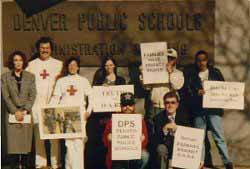History of D.A.R.E.

(click to enlarge image)
Officer Steven Havens of the Oneonta (NY) Police Department teaching students the D.A.R.E. program.
Source: "D.A.R.E.," oneonta.ny.us (accessed Jan. 20, 2010)
Proponents say that D.A.R.E. has helped prevent drug use in elementary, middle, and high school students. They contend that D.A.R.E. improves social interaction between police officers, students, and schools, is the most prevalent substance abuse prevention program in the United States, and is popular with kids and parents.
Opponents say that dozens of peer-reviewed studies conclude the D.A.R.E. program is ineffective at preventing kids from using drugs. They contend that D.A.R.E. causes kids to ignore legitimate information about the relative harms of drugs, and that D.A.R.E. is even associated with increased drug use.
What Is D.A.R.E.?
D.A.R.E., an international 501(c)3 nonprofit organization, is the most prevalent drug abuse prevention program in the United States, and is often referred to as the most prevalent drug prevention program in the world. The original D.A.R.E. program was developed in 1983 as part of a joint effort between the Los Angeles Police Department (LAPD) and Los Angeles Unified School District (LAUSD) to "to break the generational cycle of drug abuse, related criminal activity, and arrest." The original curriculum consisted of core elements such as resistance, skill training, and self-esteem building, supplemented with additional information on gangs and legal issues related to drug use. The program focused primarily on what it calls "gateway" drugs, such as tobacco, alcohol, marijuana, and inhalants, which allegedly lead to harder drug use.
During its first year of implementation, the program was delivered to approximately 6 million students at a cost of $750 million (costs of approximately $125 per child). Following the initial implementation, with the help of funding from the 1994 Safe and Drug-Free Schools and Communities Act, D.A.R.E. dramatically expanded in the US and around the world. By 2001, economist Dr. Edward Shepard estimated that D.A.R.E. cost $1-1.3 billion annually (about $173 to $268 per student per year) to implement nationwide once all related expenses, such as police officer training and services, materials and supplies, school resources, etc., were factored in.
The D.A.R.E. program is funded by both private and federal government sources. Its 2011 annual report showed total revenues around $3.7 million (down from $9.7 million in 2000 and $6.6 million in 2008). Licensing royalties alone brought in $2.2 million in 2011 (59% of total revenues). D.A.R.E.'s former president, Charlie Parsons, made an annual salary of $215,040 while four other executives also earned six-figure salaries. On Nov. 14, 2012, D.A.R.E.’s Board of Directors named Executive Director and Chief Operations Officer Francisco X. Pegueros as President and CEO.
Original D.A.R.E. Curricula
The original D.A.R.E. curriculum was designed for use with elementary-aged students only, but middle school and high school components were added in 1986 and 1988 respectively in order to broaden the reach of the program. Most students receive D.A.R.E. curricula in the fifth or sixth. The core D.A.R.E. curriculum is a one-semester course taught one hour a week for ten weeks by a trained, uniformed police officer, which ends in a D.A.R.E. graduation ceremony. All police officers who teach D.A.R.E. curricula must attend and graduate from a two-week training program that includes instruction on drugs, gangs, internet safety, and teaching techniques. All students participating in D.A.R.E. must complete a student workbook and a D.A.R.E. essay, have good attendance, follow D.A.R.E. and school rules, and "be good role models and citizens” in order to graduate from the program.
Studies about the Efficacy of D.A.R.E.
Studies published in the 1990s concluded that D.A.R.E. had little to no effectiveness in preventing drug use in elementary, middle, or high school students, and may actually lead to increased drug use. Based on these studies, D.A.R.E. in 1998 failed to meet federal requirements that its program be "research based" and "effective" in order to receive federal grant money. The Department of Education in 2001 excluded D.A.R.E. from its National Registry of Effective Programs "that promote safe, disciplined, and drug-free schools." Federal funding to train D.A.R.E. officers was reduced as a result.

(click to enlarge image)
Anti-D.A.R.E. protest at the Denver Public Schools Administration building.
Source: "Activism Photos," www.kengorman.org (accessed Feb. 17, 2009)
Based on the results of this pilot study, in 2009 D.A.R.E. transitioned to a promising new curriculum called "Keepin’ it REAL." The program, developed earlier by researchers at Pennsylvania State University and Arizona State University, encourages students to "Refuse offers to use substances, Explain why you do not want to use substances, Avoid situations in which substances are used, and Leave situations in which substances are used." Since Dec. 2006, the Keepin' it REAL curriculum has made Substance Abuse and Mental Health Services Administration’s (SAMHSA) list of evidence-based drug use prevention programs. SAMHSA concludes that "no adverse effects, concerns, or unintended consequences were identified" with the program, and finds that D.A.R.E. is scientifically proven to improve four different student outcomes: alcohol, cigarette, and marijuana use; anti-substance use attitudes; normative beliefs about substance use; and substance use resistance. The National Dropout Prevention Center/Network classified Keepin’ it REAL as a "model program" in 2009. The Department of Justice, in an Apr. 2012 review of the program, determined that D.A.R.E.’s Keepin’ It REAL is "promising" because the program seemed to lower alcohol and marijuana use and improve resistance skills, but their review also found that these positive outcomes often fade over time. |
|
| RECOMMENDED to you...
|
|
1
|
|
2
|
|